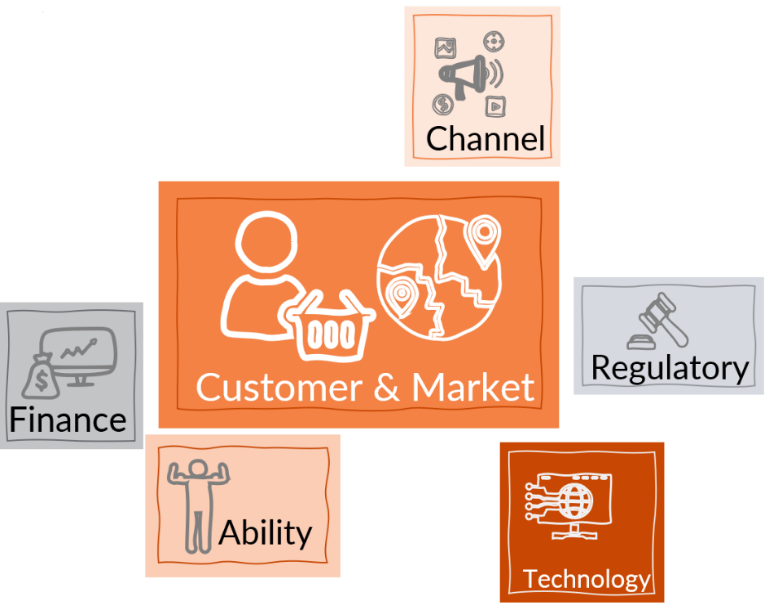
Jump To Section
Design Thinking is not new.
It started thousands of years ago when our ancestors were looking for answers from the open world by observing it, interpreting it, bit by bit adapting to it, and quickly pivoting when a critical threat is observed by their sensory knowledge.
Because of the Design Thinking approach, we survived extreme weather conditions and the deadliest of predators, and equipped ourselves with the right tools and ways of survival.
We transitioned from hunter-gathering, to growing crops and into creating industries and digitizing them.
From a cosmological viewpoint, we are merely designers, experimenters, and doers who proceed with caution.
Design Thinking helps surface the uncertainties that have some level of doubt attached to them, and then we address those uncertainties through an iterative way of proceeding with caution.
We shouldn’t forget, however, that design thinking has also been the buzzword for a decade now where small to enterprise-level organizations are continuously dedicated to establishing design thinking as a panacea.
But when organizations fail to realize the situational application of Design Thinking, they generate waste in the name of experimentation.
Shall Design Thinking Be Used in Every Situation?
Instead of using Design Thinking in every situation, there is a way to identify which situations require Design Thinking.
This can be achieved through the ‘Uncertainty Index’ for a given requirement.
Instead of using Design as a buzzword for showing some level of upskilling within the organization, these can be used selectively and more efficiently to solve the right problem for the right people.
Otherwise, it can become devastating if not used for the right problem.
The conceptual understanding of Design Thinking has been improving, where Product Managers and Designers have started to factor in different uncertainties to make it an effective method of solving customer problems.
What Are These Uncertainties?

At mobileLIVE, we believe in adopting the most effective approach to address uncertainties while minimizing waste, by identifying and researching our customers’ and clients’ true needs.
To achieve this, we suggest selectively using a set of uncertainties that can be applied to any given problem or need.
Progressive companies typically consider multiple uncertainties to ensure that design thinking is only used where it can uncover real needs.
If the company has relevant historical data, research, or expert opinions on the problem at hand, they assign an uncertainty threshold to determine whether the problem falls below the threshold and can be solved using a tried and tested approach to product development.
This approach saves time and cost while still achieving the same level of product development as a design thinking process.
With the ‘Uncertainty Index’, uncertainties of all kinds associated with a problem, a product, or service can be mapped in a singular view.
This helps us to be able to gauge better if the problem at hand warrants a design thinking approach to solving the problem, or if conventional methods need to be used for better outcomes.
The Seven Uncertainty Index
The following are the seven types of uncertainties for which a quantitative or qualitative threshold can be defined and practiced across the Products cross-functionally:
1. Customer Preference
- Insufficient or inaccurate data on customer preferences, such as incomplete or outdated market research or survey results
- Limited understanding of customer needs and pain points can result in misaligned products and services that do not meet customer expectations
- Rapidly changing customer preferences due to shifts in consumer behavior or the emergence of new technologies or trends
- Inconsistent or unreliable customer feedback and satisfaction data that can lead to inaccurate conclusions about customer preferences
- Lack of clarity or articulation of customer expectations, which can make it difficult to develop effective marketing strategies and product roadmaps
If there is minimal uncertainty related to customer preferences, it may indicate that a design thinking approach is not necessary.
Instead, product strategists can focus their efforts on leveraging existing data and research to inform their product development decisions.
This can help to optimize resources and ensure that solutions are aligned with the needs and preferences of the target customer base.
2. Market Volatility
- Rapid changes in consumer demand and supply due to changing market conditions
- Shifting consumer preferences and behaviors, including emerging trends and fads
- Technological advancements and disruptive innovations that can quickly change the competitive landscape
- Intense competition and pricing pressures, including the emergence of new competitors or business models
- Economic and financial instability, including changes in interest rates, exchange rates, and other macroeconomic factors that can impact market dynamics
If there is a low level of uncertainty related to market volatility, it may be an indication that the market is relatively stable and well-understood.
In such cases, design thinking may not be the most appropriate approach to use, as the focus should be on leveraging existing knowledge and data to drive product life cycle strategy and decision-making.
However, even in relatively stable markets, there may still be opportunities to innovate and differentiate, and a design thinking approach can still be valuable in identifying and capitalizing on these opportunities.
It is important to assess the level of uncertainty related to market volatility on a case-by-case basis and to use a range of tools and approaches to identify and minimize these uncertainties.
3. Regulatory Ambiguity
- Ambiguity in regulatory requirements and compliance standards
- Lack of clarity in legal frameworks and guidelines
- Uncertainty about how regulatory bodies will interpret and enforce regulations
- Compliance costs and risks associated with regulatory non-compliance
- Potential reputational risks associated with regulatory violations
In cases where the regulatory landscape is relatively stable and clear, design thinking may not be necessary as existing regulations can guide decision-making.
Similarly, in situations where the regulatory requirements are well-defined and leave little room for interpretation, other methodologies such as legal or compliance-focused approaches may be more appropriate.
However, if there is significant uncertainty surrounding regulatory requirements, design thinking can be useful in exploring potential solutions and identifying areas where further regulatory guidance may be needed.
It’s important to assess the level of regulatory ambiguity and determine whether design thinking is the most suitable approach for addressing the specific challenges and opportunities at hand.
4. Technological Uncertainty
- Rapid pace of technological change, which can make it difficult to keep up with new developments and trends
- Uncertainty around the commercial viability of emerging technologies, including questions around market demand, scalability, and return on investment
- Complexity of emerging technologies, which may require specialized skills and expertise that may not be readily available in-house
- Risk of technological disruption that can create new threats to established business models and markets
- Potential for emerging technologies to create new opportunities and business models, including the potential to improve operational efficiency, enhance customer experiences, and create new revenue streams
When faced with uncertainties related to technological disruptions, it’s important to assess the level of uncertainty and the potential impact on the product.
If the uncertainties are conventional and there are proven solutions or approaches that have been successful in the industry or by the organization, then design thinking may not be necessary as product strategists can rely on conventional methods.
However, if the uncertainties are more complex and disruptive, with no clear examples of successful solutions or approaches, then design thinking can be a valuable tool to help product strategists explore alternative solutions and develop more innovative products that can better meet the needs and preferences of their target customers.
5. Channel Uncertainty
- Incomplete understanding of customer behavior and preferences across various channels, which can lead to suboptimal channel selection and poor customer experience
- Uncertainty around the most effective methods to reach and engage customers through different channels, which can lead to inefficient use of resources and missed opportunities
- Limited knowledge about the costs, benefits, and risks associated with different channels, which can make it difficult to optimize channel selection and ROI
- Uncertainty about how different channels will evolve and their future viability, which can make it difficult to develop a long-term channel strategy
- Lack of clarity about the potential impact of emerging channels on existing channel strategy, which can make it difficult to effectively allocate resources and adapt to changes in the market
If there is minimal uncertainty with the channels, using design thinking as the default approach may result in unnecessary time and resource waste trying to reinvent the wheel.
However, with the rapid introduction and expansion of digital channels, it is crucial to remain present and relevant while exercising caution. In such cases, applying design thinking can help to identify opportunities for innovation and differentiation, ensuring that your organization stays ahead of the curve and delivers value to customers in new and impactful ways.
6. Financial Viability
- Limited understanding of the lifetime value of customers and the impact of customer acquisition costs on profitability
- Uncertainty about the scalability of the product and its ability to generate sufficient revenue to cover development costs and sustain the business over the long term
- Limited knowledge of the market size and growth potential for the product, and the potential impact of competitors or substitute products
- Uncertainty about the financial impact of potential legal or regulatory challenges, such as patent infringement lawsuits or regulatory hurdles
- Limited understanding of the financial implications of potential product failures or recalls, including the costs of customer refunds or compensation, legal fees, and damage to the brand’s reputation
If there is minimal uncertainty related to financial viability, it may not be necessary to use a design thinking approach and instead bank on the existing financial models and data.
7. Organizational Ability
- Lack of organizational agility and ability to adapt to changing market conditions and customer needs
- Limited capability to attract and retain top talent with the necessary skills and expertise
- Insufficient investment in training and development programs to build necessary competencies and capabilities
- Inability to effectively manage and integrate acquisitions or partnerships
- Limited ability to implement and execute strategic initiatives and goals due to siloed or bureaucratic organizational structures
If the uncertainty related to organizational ability is low, then it may not be necessary to use a design thinking approach as product strategists may already possess the necessary skills and expertise to develop and execute the product strategy effectively.
However, if there is a higher level of uncertainty in this area, it may be critical to adopt a design thinking approach to identify the right organizational skillset needed and to develop strategies to retain top talent possessing those skills to ensure successful product development and execution. The main aim remains to deliver with certainty.
Reducing Uncertainties Through the Uncertainty Index
The uncertainty score can be determined by going through each of the five uncertainties listed under the seven main uncertainty categories.
Any organization can set a rule of thumb to kickstart the design thinking process when an uncertainty score of a category is found to be above the uncertainty threshold.
Once uncertainty is mapped, the goal is to reduce it through research, rapid prototyping, and pivoting.
Analyzing uncertainties with the scope of the ‘uncertainty index’ requires domain expertise and cross-functional collaboration, but rest assured, it will save a lot of wasted efforts in terms of time and money later in the product development and launch cycle.
This example below definitely calls for sophisticated data elicitation and research using design thinking principles.

Final Takeaway
In conclusion, the uncertain business environment makes it challenging for organizations to make strategic decisions.
Design thinking can be an effective approach to navigating uncertainty and creating customer-centric solutions.
However, it is important to assess the level of uncertainty associated with the problem at hand before deciding to use design thinking.
The uncertainty index can be a useful tool in this regard, helping organizations to evaluate various uncertainties such as customer preferences, market volatility, including uneven competitive landscape, emerging technologies, channel uncertainty, regulatory ambiguity, financial viability, and organizational ability.
By carefully considering these uncertainties and using design thinking where appropriate, organizations can make more informed decisions and better position themselves for success in the marketplace.
FAQs
Is design thinking a panacea for all kinds of problems?
No, design thinking is not a one-size-fits-all solution for every problem. It is a framework that is best suited for complex, open-ended problems that require creative solutions.
Can design thinking be misused as a buzzword to create the illusion of innovation?
Yes, it is possible to misuse design thinking as a buzzword without actually achieving any tangible results. It is important to approach design thinking with a genuine intention to solve problems and create value.
Are there situations where design thinking may not be appropriate?
Yes, there may be situations where design thinking may not be appropriate. Those problems with low levels of uncertainty usually don’t require the design thinking approach such as when the problem is well-defined and has a clear solution, or when time and resources are strictly limited.
Can design thinking be used as a substitute for domain expertise?
No, design thinking is not a substitute for domain expertise. It is a complementary approach that can be used in conjunction with the domain expertise to generate innovative solutions.
Is it important to involve stakeholders in the design thinking process?
Yes, involving stakeholders in the design thinking process is critical to ensuring that the solutions generated are relevant and meet the needs of the end users and all entities in between. The associated uncertainties spread across different disciplines within an organization to be well understood, followed up and reduced.
Is it important to evaluate the problem for uncertainties before using design thinking?
Yes, it’s very important to evaluate the problem for uncertainties as it helps in identifying potential challenges and opportunities that may affect the outcome of the process. This evaluation can also help in adjusting the process to accommodate any unforeseen obstacles.
Is it important to evaluate the success of design thinking initiatives?
Yes, it is important to evaluate the success of design thinking initiatives to determine their effectiveness and identify areas for improvement.



